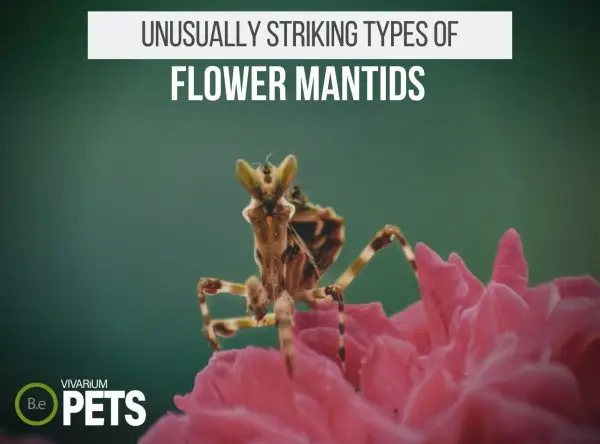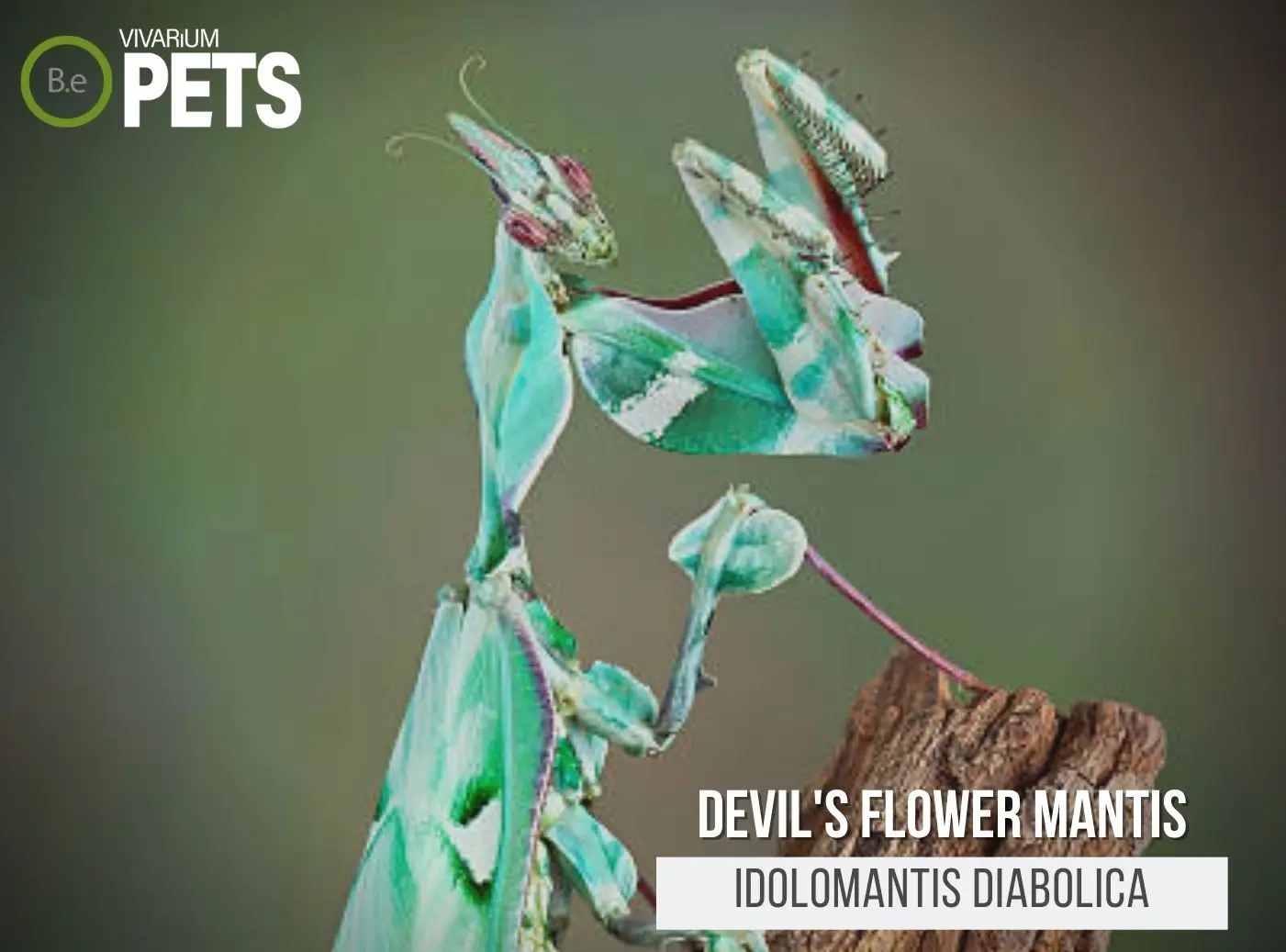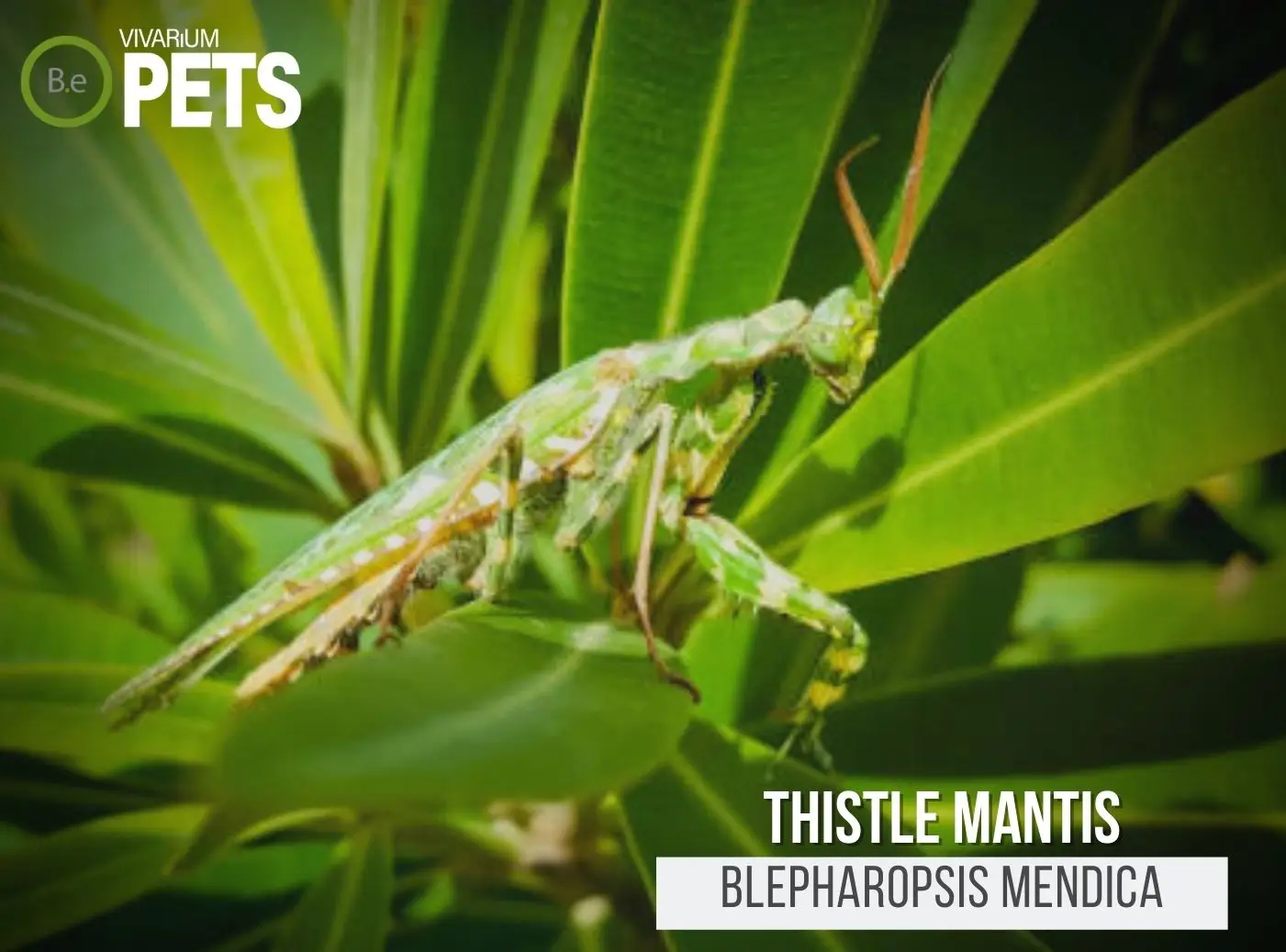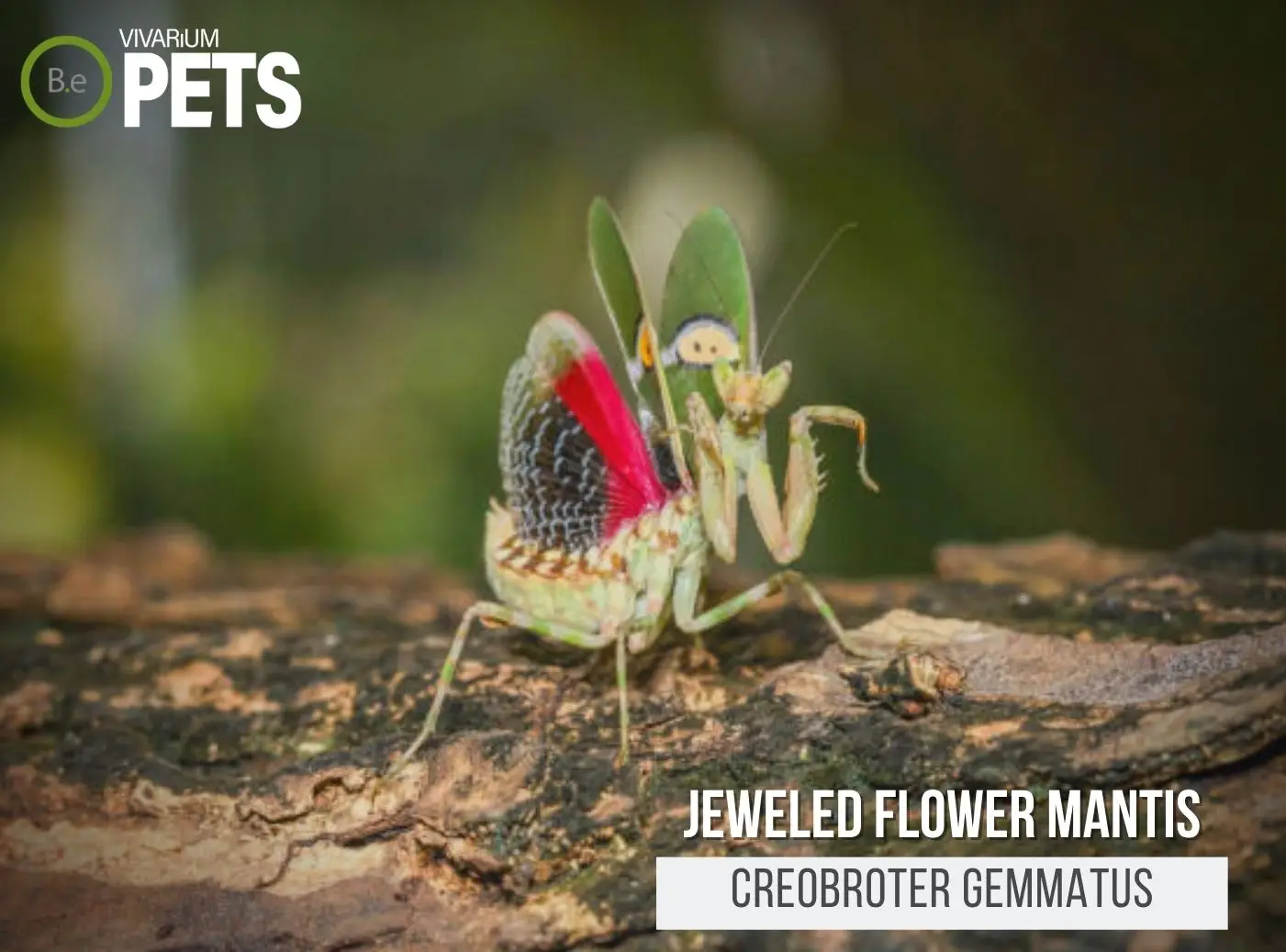Flower Mantis are fascinating creatures, beloved by hobbyists for their unique colors and unusual shapes.
With so many different species living throughout the world, there’s certainly something for everyone if you’re considering keeping one as a pet.
In this article, we‘ll explore twelve types of Flower Mantis, their colors, shapes, and habitats.
Additionally, we‘ll provide advice on which of these blossoming pet praying mantis to choose for your enclosure, as well as the best ways to shop for one.
Table Of Contents:
ToggleWhat Is A Flower Mantis?
Flower Mantis are a beautiful and unique group of insects, belonging to the order Mantodea.
There are over 2,400 species of flower mantis, which can be found across Asia, Africa, and North, Central, and South America.
These insects are distinguishable from other mantids by their bright colors and flower-like camouflaging.
These colors and shapes help the mantis blend in with their environment and many species even have crests and wings that mimic flowers.
Flower mantes can range in size, typically from 1 – 18 cm in length as adults, depending on the species as well as gender.
Most flower mantes are predatory, waiting until their prey is close before striking with their raptorial front legs.


Types Of Flower Mantes
Various types of flower mantis display common features such as large compound eyes, long spiny legs, and sometimes even wings.
However, each type also has unique features that distinguish them from one another.
Some of these praying mantes, for example, boast colorful patterns with vibrant colors, while other mantids have a unique body shape better-resembling leaves and flower peddles.
Furthermore, there are a few species of mantes that have robust bodies and much shorter wings than most other varieties, giving them the appearance of more realistic orchids or lilies.
With that in mind, here’s a list of exotic flower mantes that have evolved to be the ultimate master of cloaking:
Orchid Mantis (Hymenopus coronatus)
The Orchid Mantis is a striking and instantly recognizable Flower Mantis species that is endemic to various parts of Southeast Asia.
This insect has a unique and beautiful appearance, with its bright pink and white coloring and elaborate, jewel-like patterns.
Orchid Mantis is typically found in rainforests and other parts of the tropics, clinging to the undersides of leaves, branches, or even flowers.
Their diet consists mainly of small insects, making them an ideal pet for hobbyists who appreciate stunningly beautiful creatures.
If you want more specifics on this flower mantis, here’s a complete care guide on Orchid Mantis (Hymenopus coronatus).
Devil’s Flower Mantis (Idolomantis diabolica)
The Devil’s Flower Mantis is a type of flower mantis native to Africa, primarily the eastern and southern parts.
This type of mantis is large, with females reaching up to 13 cm in length, and is seen in a wide array of shades including green, orange, grey, and even pink.
They are also known for their striking face masks. Contrary to their name, however, the Devil’s Flower Mantis is not particularly aggressive and is less likely to leap at potential prey than other species.
Still, they are fast predators, equipped with powerful mandibles and hooks on their abdomen for grabbing prey.
Devil’s Flower Mantis also live in extreme climates, including the desert and rainforest, and are voracious eaters, able to consume just about anything they can catch hold of.
Adding one of these striking mantises to your enclosure can be an excellent choice, as long as you provide the right environment for them.
If you want more specifics on this flower mantis, here’s a complete care guide on Devil’s Flower Mantis (Idolomantis diabolica).
Spiny Flower Mantis (Pseudocreobotra wahlbergii)
The Spiny Flower Mantis is a species of mantis native to tropical and subtropical Africa.
It has a large, triangular-shaped body and is typically a bright yellow or reddish-orange color.
It also has an unusual, spiny appearance with a thick carapace and long spines that branch off from its body.
This species of Flower Mantis is active during the day and prefers to hunt in shady, damp areas.
It primarily consumes small insects such as mosquitoes, moths, and flies.
With proper care, the Spiny Flower Mantis can be a wonderful pet for those who want to keep a distinctive, truly unworldly insect.
If you’re looking for more specifics on this flower mantis, here’s a full care guide on Spiny Flower Mantis (Pseudocreobotra wahlbergii).
Wandering Violin Mantis (Gongylus gongylodes)
The Wandering Violin Mantis is an absolutely stunning species of Flower Mantis.
Native to the Indian subcontinent, they have a beautiful brown-peach body, with iridescent dark accents and two long, slender filaments extending from their heads.
As adults, they tend to have a distinct violin or jack-o-lantern shape and are considered one of the larger species within the Flower Mantis family.
Along with their impressive size, they are highly adaptive, capable of living in almost any environment.
All in all, the Wandering Violin Mantis makes an amazing and captivating pet.
If you’re looking for more specifics on this flower mantis, here’s a full care guide on Wandering Violin Mantis (Gongylus gongylodes).
Thistle Mantis (Blepharopsis mendica)
The Thistle Mantis is a type of Flower Mantis native to North Africa and the Middle East.
It is characterized by its colorful wings that are predominantly white or yellow at the base but can contain other colors such as green, blue, or brown.
This mantis also has extremely long and thin forelegs, making them appear delicate and delicate-looking.
Thistle Mantis prefer low and arid environments, although they can also be found in lightly wooded areas.
They are an easy-to-care-for species and can be kept in cages or terrariums that are both heated and cooled.
In terms of feeding, they tend to prefer aphids, roaches, and springtails.
If you’re looking for more specifics on this flower mantis, here’s a full care guide on Thistle Mantis (Blepharopsis mendica).
Banded Flower Mantis (Theopropus elegans)
The Banded Flower Mantis is a popular species of flower mantis found in Southeast Asia.
They are easy to recognize by their distinct yellow, black-and-white striped pattern, which resembles a flower.
They typically measure about five centimeters in length and have a slender body with long, thin spines.
Banded Flower Mantises are active hunters and are known to ambush larger prey such as moths and even spiders.
They prefer to live in moist, sheltered environments, such as in tree bark or amongst leaf litter.
With the right care and environment, they make excellent pets and are a great addition to any insect lover’s collection.
If you’re looking for more specifics on this flower mantis, here’s a full care guide on Banded Flower Mantis (Theopropus elegans).
Conehead Mantis (Empusa pennata)
The Conehead Mantis is a type of flower mantis native to the Mediterranean region, Africa, and the Middle East.
It is known for its distinctive cone-shaped head and voracious appetite, having been observed preying on multiple types of arthropods as well as small birds.
The Conehead Mantis is a medium-sized species of Flower Mantis, typically reaching an adult length of 3 to 4 inches.
It is a colorful species, typically featuring shades of green, brown, and yellow with white patches.
Its unique cone shape and vibrant colors make it a popular choice among insect hobbyists.
If you’re looking for more specifics on this flower mantis, here’s a full care guide on Conehead Mantis (Empusa pennata).
Jeweled Flower Mantis (Creobroter gemmatus)
The Jeweled Flower Mantis is a type of mantis characterized by its vibrant, colorful display.
Native to India and Sri Lanka, it typically lives close to the ground in a variety of vegetation types, including wildflowers, shrubs, and trees.
They come in a variety of colors, including metallic green and red.
These mantids tend to be quite hardy and easy to care for, making them ideal beginner mantis.
They’re also relatively small, ranging from one to two inches in size, and have adapted well to captivity, requiring limited amounts of misting and heat.
When searching for the perfect pet, keep an eye out for the Jeweled Flower Mantis – its stunning colors will surely be hard to resist!
If you’re looking for more specifics on this flower mantis, here’s a full care guide on Jeweled Flower Mantis (Creobroter gemmatus).
Yellow Flower Mantis (Helvia cardinalis)
Yellow Flower Mantis are a stunning species of Flower Mantis, native to South Africa.
They are one of the most beautiful and rarest species in the mantis family, with a bright yellow and black coloration and intricate wings.
In the wild, they inhabit tropical areas and dry forests and tend to feed on smaller insects.
When kept as pets, they require an enclosure with high temperatures and lots of foliage for hiding.
They prefer to eat small crickets, but can also consume fruit flies and other small invertebrates.
While they are relatively peaceful, they can still be quite territorial, so it‘s important to provide adequate space for them to thrive.
With the proper care, Yellow Flower Mantis can make wonderful pets for any insect–lover out there.
Nigerian Flower Mantis (Chloroharpax modesta)
Nigerian Flower Mantis are brightly colored mantis, native to Africa.
They feature several bright hues, usually including pink, yellow, orange, and purple.
While they are smaller than other species, they could reach up to 4 cm long and come in a variety of winged and non-winged variations.
They are nocturnal and tend to be found in parts of Africa with heavy vegetation including rainforests and grasslands.
Nigerian Flower Mantis requires high humidity and warm temperatures within their enclosures and feed mainly on insects and other invertebrates.
With regular misting, they can be kept alive for up to 8-12 months in captivity.
Gambian Spotted-Eye Mantis (Pseudoharpax virescens)
Gambian Spotted-Eye Mantis (Pseudoharpax virescens) is one of the more popular types of Flower Mantis.
They are native to sub-Saharan Africa and are easily recognizable by their yellow bodies and their contrasting black, red, and white markings.
They are a hardy species, and relatively easy to care for, as long as their habitats are warm and humid.
They boast a wide range of colors, from yellow to orange to green, and their wings have colorful spots that give rise to their name.
They typically grow to a size of 2 inches with adults reaching 3 inches.
These Flower Mantis need a wide array of live food, such as crickets, small caterpillars, and flies, making them ideal companions for hobbyists.
Taiwan Flower Mantis (Acromantis formosana)
Taiwan Flower Mantis is a species of Flower Mantis native to Taiwan and nearby islands in the South Pacific.
It is named after the beautiful flowery shapes that decorate its wings and body.
The mantis has two sets of wings, the first set is white with red stripes, and the second set is typically lime green with floral patterns.
Its size can range from 2-3.5cm in length, and it prefers areas with high humidity and plenty of camouflaging foliage.
Taiwan Flower Mantis is an active and friendly mantis, with an easy-going disposition.
It exhibits a range of interesting behaviors, and it is an ideal pet for novice mantis enthusiasts.
Choosing The Right Flower Mantis
Matching and choosing the right flower mantis is an essential step when considering keeping one as a pet.
It‘s important to be aware that each species of flower mantis has its own unique preferences for climate and living environment.
For example, some tropical species of mantis prefer a warmer climate while others prefer cooler conditions.
While they may all belong to the same order, they do have subtle differences in care requirements and habitat.
It’s best to research and read up on each species to determine which one is best for you before making a purchase.
Shopping For a Flower Mantis
When looking for a Flower Mantis, it is crucial to find a reputable dealer.
Make sure to research the type of seller you are buying from, and check reviews and customer feedback before making a purchase.
In the end, your best bet for finding a Flower Mantis is online.
There are a variety of online vendors who specialize in selling these unique creatures, many of whom offer specific types tailored to your needs.
Additionally, you may find a variety of rare varieties through online forums and platforms that connect hobbyists with each other.
Before making any purchase, make sure to read the terms and conditions of sale to ensure you are getting healthy and well-cared for Mantis.
Conclusion
In conclusion, Flower Mantis can make fascinating and unusual pets for hobbyists of all types.
With these twelve distinct species, there’s a flower mantis to fit any budget, enclosure, and preference.
When deciding which type of mantis is best for you, be sure to consider the size, color, shape, and weight of each species before making a purchase.
With the right care and attention, these beautiful creatures can meet or surpass their maximum life expectancy!
Frequently Asked Questions
Yes, flower mantis can make great pets. They are relatively easy to care for and provide interesting visuals with their unique colors and shapes.
Take care of a flower mantis by providing a warm and humid environment, offering a variety of food, and ensuring adequate nutrition. Additionally, regular monitoring of the enclosure can help identify any potential issues in a timely manner.
Some species of Flower Mantis can be mildly aggressive, though they usually only attack when provoked.
yes, some species of flower mantis can be rare and hard to find in stores, especially the exotic ones from Asia and South Africa.
On average, Flower Mantis live for 6 to 12 months.








